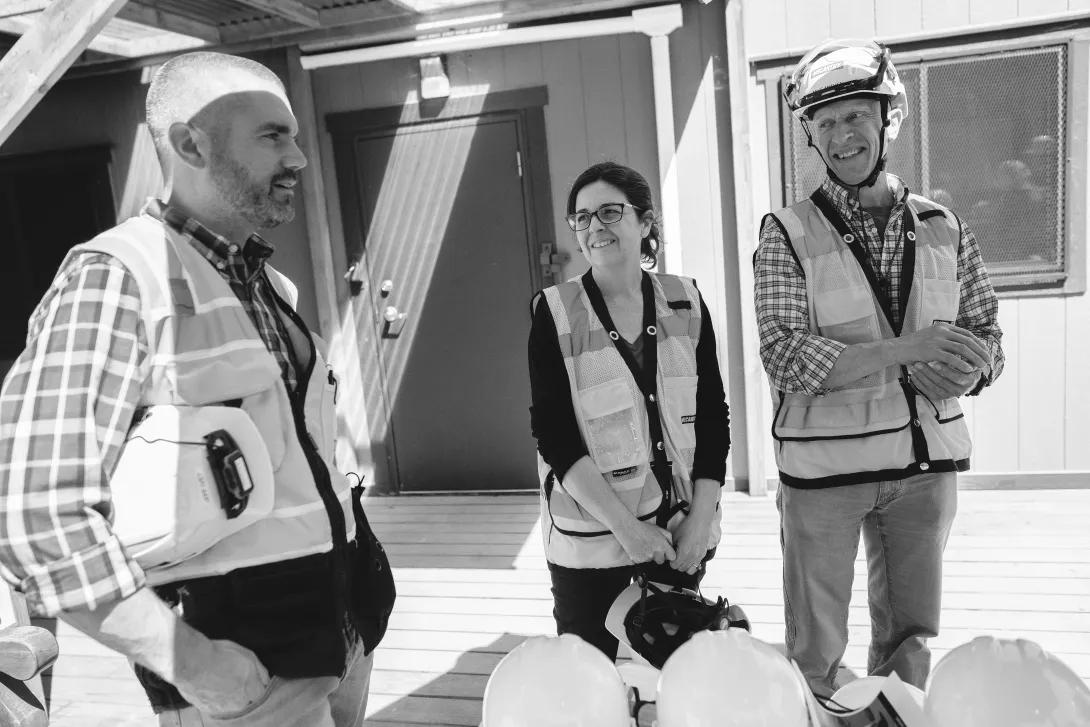
What it’s like to work on the GSE’s most complicated campus construction project
One of the most intricate parts of Stanford Graduate School of Education’s (GSE) campus construction project is the education building, also known as the north building.
Design teams and construction workers were tasked with preserving most of the exterior of the building, which was originally designed in the 1930s, while giving the rest of the building a modern upgrade.
“Back in 2017, when we started the architectural interviews for the project, we knew that the north building was a dear and cherished historical resource,” said Michael Mithen, senior project manager at Stanford University’s Department of Project Management. “So we’re keeping the historical fabric intact while also paving the way for the GSE to accomplish its mission into the future.”
For a large part of the process, this twofold goal required that construction workers effectively gut the building’s interior while creating supports that kept its exterior shell in place.
“Everyone involved takes the sensitivity of this project to heart,” said Jeff Ivey, senior project manager with McCarthy Building Companies, Inc., the company working on construction.
Here, Mithen and Ivey discuss balancing the old and the new, their favorite facets of the north building, and what they’ve learned along the way.

Jeff Ivey (left) chats with GSE assistant dean of finance and strategic initiatives Olivia Crawford (center) and Michael Mithen (right) before a faculty tour of the construction site. (Photo: Ryan Zhang)
Is it difficult to pull off a project like the north building, where you demolish what’s inside while keeping the exterior intact?
Ivey: It’s certainly the biggest challenge on the job, and it makes for an interesting build. You get a lot more opportunities to do things that you don’t typically do on a normal project. For example, for the north building’s north wall that’s remaining intact, we’ve demoed out the entire core, and that wall is the only thing that is to remain. We had to build out a sizeable slab [a foundation resting on the soil that supports the building] within the sunken garden and are bracing that wall with some structural elements to keep it in place.
Mithen: Not every renovation project is this extensive or really gets into the guts as far as we have. In this project, we’re continuing the structural strengthening that was done 13 years ago and making the building safer, as well as providing better usability.
How are the construction and design teams balancing the old and new elements of the north building?
Ivey: One thing that should be noted, from a sustainability standpoint, is that we’re maintaining most of the original Spanish tiles. We removed them, palletized them and we'll be cleaning and reinstalling them.
A lot of those old elements stayed the same, and then we’re adding a more modern look with the curtain wall [an exterior covering made of windows] on that south exterior and the courtyard that connects the two buildings.
Mithen: The curtain wall was a very intentional update to the building. We worked closely with the university architect’s office to make sure this buildout was appropriate, and that there were other precedents where historical structures incorporated a more modern building element.
What are your favorite parts of the north building?
Ivey: I’m partial to what used to be the library, which is now going to be the great room. There’s this steel truss structure in the great room, which is not going to be visible once everything’s done, but it’s a very interesting element to a very old building. If you love building and knowing how things work and get put together, it makes it much more enjoyable to see those engineering elements.
Mithen: I would also say that the great hall on the second floor is dramatic. There is a big wow factor when you walk into that space, especially if you recall what the space looked like previously. The sunken garden, too, where all of Jeff’s temporary supports for that north wall are right now — that’s going to be a terrific space that we really didn’t have before this project.
With a project this complex, there are bound to be adjustments along the way. What was the problem-solving process like?
Ivey: An example was that we had to improve the foundation of the structure — which means there’s a lot of over-excavation that needs to be done to pour new footings below grade, to brace the new structure. The soil-bearing pressure and the existing structural constraints we faced made it a challenge to sequence throughout the building. To put it simply, if you dig a hole, you have to fill it with concrete before you move on to the next hole.
From a superintendent’s standpoint, or for anyone who is driving a schedule, you would like to do it all at the same time. But we couldn’t do that, because after you dig one hole, if you dig another, you could compromise the structure.
Mithen: It also helped to have these monitoring points at different parts of the building where the team surveys basically every day to see if there have been any micro movements and make sure the building remains stable.
Could you summarize the work that remains to be done on the north building?
Ivey: It’s tying the building back together, which includes the structural steel that’s going to go on the interior and the core. Once we have the building shell and we put the roof on, it’s going to be an interior buildout after that. We’re looking to dry the building in [protecting it from the elements and ready for interior work] going into this next winter.
Mithen: We’ll also have the exterior site elements — there’s the landscaping and the courtyard that will be between the three buildings, including Barnum. So there is still quite a bit of site work and some nice [exterior] gathering spaces that will be created while the interior work continues.
We still have a little over a year to go with the main construction, but we’re through the really difficult part, and the north building is going to come together in a really exciting way.



